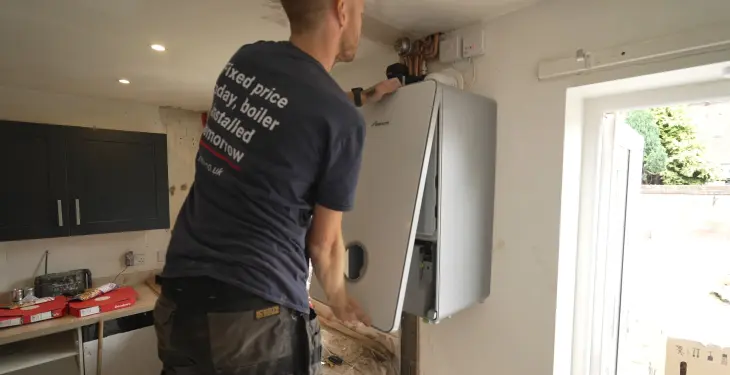

Written by Stephen Day
Gas Safe Engineer
Updated: 30th May, 2025
Common issues include low water pressure or failure to ignite, indicated by specific error codes. Understanding these codes is crucial for quickly diagnosing and solving boiler issues without stress.
Get a new boiler quote, save up to £550 per year (0% APR available).
Owning a boiler is essential for many households, especially during the colder months. When it comes to reliable heating, Ariston boilers are a popular choice among homeowners across the UK. Despite their reliability, these boilers, like any appliance, may encounter problems. Common issues include low water pressure or failure to ignite, indicated by specific error codes. Understanding these codes is crucial for quickly diagnosing and solving boiler issues without stress.
Knowledge of these error codes, such as SP1, SP2, and 108, can save time and money on costly repairs. For example, a low water pressure error might display as code 108, prompting the user to address this specific issue. Regular boiler servicing by a professional can help maintain efficiency and safety, reducing the chance of dealing with malfunction codes.
Boiler error codes like 501 or E43 might suggest more technical problems, such as pilot light issues or air pressure switch faults. By addressing these problems promptly, homeowners can ensure continuous comfort and avoid unexpected breakdowns. For an enjoyable and efficient home environment, understanding Ariston boiler error codes is a key step.
Get a quote in 60 seconds, fitted as fast as next day!
0% APR finance available.
Ariston boilers can encounter a variety of issues, each with specific error codes. These codes help identify the problems quickly.
One frequent issue with Ariston boilers is low water pressure, highlighted by a Fault Code 108. This can disrupt both heating and hot water functions.
Ignition problems often flash Fault Codes SP1 or SP2. With these errors, the boiler fails to ignite, affecting both central heating and domestic hot water supply.
A lack of a pilot light typically results in Fault Code 501. Without this light, the boiler cannot heat water, leading to interruptions in service.
Errors in the printed circuit board carry Fault Codes 301-307. These problems can cause significant system disruptions and often need professional repairs.
Ariston fan faults display as Fault Code A41. These issues can lead to overheating or inadequate heat distribution in multi-zone heating setups.
When the air pressure switch is faulty, the boiler may display Fault Code E43. This component is crucial for maintaining the proper air and fuel mix.
Errors in the external sensor circuit or floor thermostat contact can disrupt the central heating circuit. The floor thermostat and heating delivery probe are key to maintaining efficient heating.
Issues with solar collectors, such as overheating or frost protection failures, affect both combi and system boilers, compromising energy efficiency and heating operations.
Understanding these common problems and their corresponding codes can significantly aid in boiler repair efforts, ensuring effective and efficient resolution.
Low water pressure in Ariston boilers is a common issue that leads to malfunction, often indicated by fault code 108. Understanding the causes, how to fix them, and when to call a professional is essential for maintaining boiler efficiency.
Low water pressure in boilers, like those from Ariston, frequently stems from insufficient water in the system. Leaks in pipes or radiators may reduce water levels, leading to decreased pressure. Another cause might be the recent bleeding of radiators, which unintentionally lowers system pressure. Additionally, problems with the pressure relief valve could also contribute, allowing water to escape from the system.
Regular maintenance can help detect these issues early. Older systems are especially prone to such problems due to wear and tear. Homeowners should monitor their boilers to avoid recurring situations. Keeping an eye on the pressure gauge is a simple way to ensure the system remains in the correct range.
Resolving low water pressure in an Ariston boiler often begins with checking the pressure gauge. Ideally, the pressure should be between 1 and 1.5 bars. If below this, topping up the system is necessary. This can typically be done by opening the filling loop valves, allowing water to enter until the desired pressure is achieved.
It's important to securely close the valves once the adjustment is made. In cases where leaks are evident, repairing or replacing the affected parts may be required. It is equally vital to inspect the pressure relief valve for any possible faults. Regular checks can prevent future issues and ensure the system runs smoothly.
If low water pressure persists despite self-checks and adjustments, contacting a Gas Safe Engineer is advisable. Persistent issues might indicate more complex problems requiring professional intervention. Boiler systems involve intricate components that can be dangerous if handled improperly.
Gas Safe Engineers possess the expertise to diagnose and resolve deeper problems within the boiler. Some repairs or replacements like fixing pressure valves or components inside the boiler itself might need their professional touch. Safety should always be a priority, so when in doubt, delegate repair tasks to a certified engineer.
If an Ariston boiler shows error codes SP1 or SP2, it indicates an ignition problem. This can affect the boiler's ability to provide hot water or heat. Understanding the reasons behind ignition failures and knowing how to address them is important for maintaining the boiler's functionality.
Ariston boilers may fail to ignite for several reasons. These include faults with the ignition electrode or the spark generator. A blocked burner or a pilot jet clogged with debris can also hinder ignition.
Another issue is a faulty gas valve, which may prevent gas from properly reaching the burner. Additionally, air trapped in the gas supply could interfere with ignition. Flame detection problems, such as no flame or flame detected with a closed gas valve, can lead to error codes SP1 or SP2.
To diagnose ignition problems, begin by checking the ignition electrode for any signs of damage. Inspect the spark generator and the pilot jet for blockages or wear. Ensure the gas valve is operating correctly and the gas supply is uninterrupted.
If air is present in the gas supply, purging the system may be necessary. If the problem persists, consulting a professional technician is advisable. They can assess components like the printed circuit board (PCB) and other complex parts. Addressing these issues promptly can help prevent further faults and maintain boiler performance.
Ariston boilers can experience problems with their pilot light, indicated by fault code 501. This issue can prevent the boiler from heating water or providing warmth. Common causes include a blocked flue or a problematic thermocouple. Proper diagnosis and repair can ensure efficient boiler performance.
One main cause of pilot light issues in Ariston boilers is a malfunctioning thermocouple. This safety device detects heat from the pilot light and controls the gas valve. If it's faulty, the gas valve may not open, stopping the pilot light from igniting.
Blockages in the boiler's flue can also cause problems. A blocked flue prevents exhaust gases from venting properly, affecting the airflow needed for the pilot light. Another potential issue is a failing gas valve, which can prevent gas from reaching the pilot light, stopping ignition.
External factors like draughts or a sudden drop in gas pressure can also cause the pilot light to fail. Regular maintenance can help identify these problems early on, preventing more significant issues down the line.
Addressing pilot light problems starts with inspecting the thermocouple. If it’s damaged or worn, replacement is necessary. It's crucial to have this done by a professional to ensure safety and accuracy. Cleaning the pilot jet can also assist in proper ignition.
Check the flue for blockages, removing any debris that may interfere with airflow. A professional should handle this to avoid damaging parts of the boiler.
Regularly checking the gas valve can prevent failures. Ensure it's working correctly and supplying gas as needed. Engaging a qualified technician to examine boiler components will provide peace of mind and maintain the system’s efficiency.
The printed circuit board (PCB) in an Ariston boiler is essential. When fault codes 301 to 307 appear, it indicates a malfunction. These codes suggest issues such as communication or EEPROM errors. Proper diagnosis and repair are required to ensure the boiler functions efficiently.
The PCB acts as the control hub for the boiler. It communicates with various components, sending and receiving signals. This ensures every part functions correctly. If the PCB fails, it can lead to major disruptions in operation.
Communication errors and EEPROM issues can arise within the PCB. These problems might result from water damage, faulty wiring, or power surges. Recognising these issues early helps prevent further damage. Regular maintenance and checks can identify potential PCB problems before they escalate.
Identifying a PCB issue involves checking the display panel for error codes 301 to 307. These codes alert the user to a PCB malfunction. Common causes include burnt circuits or loose connections.
To repair, first, inspect wiring and connections for any visible signs of damage. If the problem persists, replacing the PCB might be necessary. Consulting with a professional ensures a safe and efficient repair.
For those comfortable with DIY fixes, ensure the boiler is turned off and follow manufacturer instructions carefully. If unsure, it's best to contact a certified technician. Regular inspections can prevent these errors and extend the life of the boiler.
Fault code A41 shows up when an Ariston boiler's fan is not working right. This code means there might be trouble with the fan's speed or overall function. Identifying and fixing this problem ensures the safe operation of the boiler.
The fan in a boiler is critical for safety. It pushes harmful gases out through the flue, stopping them from staying inside. A working fan keeps the boiler running safely and stops gas from building up. Insufficient fan speed can make the boiler unsafe and cause it to shut off to prevent risks.
A41 fault code appears when the fan does not operate properly. This might be due to dirt, engine faults, or wiring issues. Understanding and fixing these causes is vital for the boiler to function properly. Without addressing them, the risk of gas leaking increases, which can be extremely dangerous.
Fixing a malfunctioning fan is crucial for both safety and efficiency. First, switching off the boiler and checking the fan for obstructions can sometimes resolve the problem. Look for any signs of dirt or build-up that might slow down the fan's speed. Cleaning the fan blades can help correct issues related to dirt.
If the problem persists, contacting a professional engineer is recommended. They will perform a detailed inspection and check the wiring and motors. Replacements may be necessary if the motor or the fan itself is damaged. Correcting these problems promptly helps restore the boiler’s performance and maintains safe operation standards.
The air pressure switch in an Ariston boiler is key to its safe and efficient operation. It monitors the boiler’s airflow, ensuring combustion occurs correctly. When the switch fails, marked by Error Code E43, it can halt boiler function, causing discomfort and inconvenience.
The air pressure switch checks if there’s proper airflow before starting the boiler. This process is crucial because it prevents dangerous situations caused by poor combustion.
A malfunction may stem from blockages in vents or flues, causing Error Code E43. Detecting and fixing errors quickly can ensure safer operation and avoid additional damage. Regular maintenance of the boiler can help prevent such issues from occurring by keeping the airflow clear.
Handling Error Code E43 usually requires expert intervention. Technicians will inspect venting systems and clean any blockages.
After clearing vent issues, they may test and replace the air pressure switch if it’s faulty. Replacing the switch can prevent recurring problems. For resolving such matters, hiring a certified technician ensures both the accuracy of the repair and the safety of the boiler.
Replacing a boiler can be a big decision. It depends on factors like the condition of your current boiler and the cost of repairs compared to the price of a new one.
Old boilers often show key signs they might need replacing. Frequent breakdowns are a red flag. If your boiler regularly fails and repairs are needed often, it might be time for a new one.
Increased energy bills can also be a sign. Older boilers may lose efficiency and use more energy to produce the same amount of heat. Strange noises or leaks are also signs to look out for, as these can mean internal components are failing.
If your boiler is over 15 years old, consider replacing it. Modern boilers are more efficient and may offer better reliability and features. Ensuring your boiler meets your home's demand is crucial for both comfort and cost-efficiency.
When deciding between repairs and buying a new boiler, considering the costs is essential. Frequent repairs can quickly add up. If these costs are close to the price of a new boiler, purchasing a new one might be more economical.
Look at the efficiency of your current boiler. If it’s not highly efficient, a new boiler can reduce your energy bills. Calculate the long-term savings on energy costs when considering options.
Additionally, newer models often come with warranties that can save on future repairs. Investing in a new boiler can provide peace of mind and enhanced safety features while ensuring consistent performance and possibly saving money in the long run.
Get a quote in 60 seconds, fitted as fast as next day!
0% APR finance available.
Last updated: 30th May, 2025

Written by Stephen Day
Gas Safe Engineer at iHeat
Stephen Day is a Gas Safe registered and FGAS certified engineer with over 20 years of hands-on experience in the heating, cooling, and renewable energy industry, specialising in boiler installations, air conditioning, and heat pump systems.
LinkedInArticles by Stephen Day are reviewed by iHeat’s technical team to ensure accuracy and reliability.

22nd December, 2025
Based on data from over 7000 boiler installations completed by iHeat in the past 12 months...
 Read Article
Read Article

22nd December, 2025
Here’s a quick roundup of the best combi boilers for 2026.
 Read Article
Read Article

22nd December, 2025
When your old boiler breaks down and it comes time to replace it with a new one, it might...
 Read Article
Read Article
No obligation. Takes less than 60 seconds.